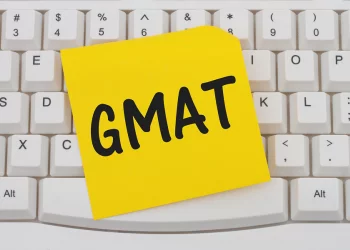
Since then, the GMAT timeline has gone through quite a few changes. In this article, we take a look at the most notable changes and milestones that happened throughout the years up until 2019. It is not only interesting to follow the history of this important tool for graduate admission but it is also useful for those planning to sit the exam today.
1953: The test is created
It all started with a collaboration between the Educational Testing Service (ETS) and nine business schools from the US – Columbia, Harvard, Northwestern, Rutgers, Seton Hall, University of Chicago, University of Michigan, University of Pennsylvania, and Washington University in St. Louis. In 1953, their representatives met and discussed the need to introduce a standardized testing method for the admissions process of their schools. They came up with this aptitude test which would assess the quality of candidates and estimate their potential to succeed in management programs without testing any particular subject matter expertise.
When the exam was created, it was called the Admission Test for Graduate Study in Business.
1961: Data Sufficiency questions are added
Data sufficiency questions, which measure the ability to analyze quantitative problems, were not initially included when the test was created. They were added in 1961 and they are an important part of the GMAT Quantitative section today.
Check out: GMAT Tutorials: GMAT Quant – Data Sufficiency
1970: Council is formed
Although it bore a different name then, the Graduate Management Admission Council (GMAC) was established as a non-profit association of business education institutions. In 1970, there were 30 graduate business schools as members. To this day, the council is “actively committed to advancing the art and science of admissions by convening and representing the industry.” The GMAC is based in the US but also has offices in the UK, India, and Hong Kong.
1976: Test name changes
The exam received the name we all know today in 1976 when the “Admission Test for Graduate Study in Business” became the “Graduate Management Admission Test”.
1994: Analytical Writing Section is introduced
Testing the writing and editing abilities of candidates became more and more important throughout the GMAT timeline. This emphasis culminated in the addition of the Analytical Writing Section (AWA) which gives schools a better idea of an applicant’s writing and their overall critical thinking and communication skills. Notably, the AWA section is scored separately and it is not part of the final GMAT result of test takers. The final GMAT score range is between 200 and 800 and consists of the Quantitative and Verbal section results only.
Check out: The GMAT Analytical Writing Assessment Section
1997: Format becomes computer-adaptive
In an effort to improve the test taker’s experience and modernize the exam, the GMAT adopted the computer-adaptive format. Thanks to this introduction, the GMAT became much more widely available and allowed more flexibility for candidates. The Economist explains:
With its ability to choose questions based on your previous answers, each GMAT exam is nearly unique.
What exactly does “computer-adaptive” mean? In a CNN article from 2005, GMAC president and CEO at the time, David Wilson, elaborated:
The first multi-choice question is at a standard level. If a candidate gets that right, then they are offered a more difficult question. If not, they are given an easier question. This ends up giving an accurate indication of a person's capabilities.
The computer-adaptive component has remained the same since 1997.
2012: Integrated Reasoning section is added
The more recent changes in the GMAT timeline have to do with the content and the way it is structured. In 2012, the GMAT added a new section called Integrated Reasoning. In a nutshell, its purpose is to analyze how well candidates can interpret tables, graphs, and other types of data. Similarly to the AWA section, Integrated Reasoning also has its own separate score, but make no mistake – it is just as important as the rest of the sections on the GMAT. Business school representatives say that Integrated Reasoning assesses skills which are much closer to those that professionals actually get to study in management programs.
Check out: Does the GMAT Integrated Reasoning Section Matter?
2014 and 2015: Policy changes regarding canceling and reinstating scores
As for changes in policy, the association administering the GMAT added some options for score cancelation and reinstatement a few years ago. Candidates now have 72 hours after obtaining their results during which they can cancel their scores. Canceled scores will not be visible on the GMAT score reports that schools receive, making this a handy option for test takers who are not satisfied with their current results. The change went into effect in 2015.
2017: Section order becomes flexible
While up until 2017 all test takers had to follow a uniform exam structure beginning with the AWA section, this is no longer the case. Everyone is now able to choose between three alternatives:
- Analytical Writing Assessment, Integrated Reasoning, Quantitative, Verbal
- Verbal, Quantitative, Integrated Reasoning, Analytical Writing Assessment
- Quantitative, Verbal, Integrated Reasoning, Analytical Writing Assessment
Immediately prior to beginning the exam, test takers choose the structure they wish to follow, and they cannot switch to a different option later. According to the administrators of the GMAT, this is a step further in improving the overall testing experience for candidates. Choosing the section order yourself enables you to use the approach that works best for you. You can start with what is most difficult to get it out of the way or begin with a section which is less challenging to get into the rhythm.
2018: Number of questions and exam duration are reduced
Finally, we reach the GMAT as it looks today!
As of 16 April 2018, the number of questions and allocated time for the Quantitative and Verbal sections were reduced. GMAT Quant now consists of 31 instead of 37 questions and has to be completed in 62 minutes. GMAT Verbal consists of 36 instead of 41 questions within a time slot of 65 minutes. This change also decreased the overall testing time by about half an hour, which saves valuable time and helps decrease the stress for examinees, explains the administrating organization. Everything else – format, content, question types, and scoring – remains the same.
While the GMAT timeline has gone through some changes and improvements since its creation, in its essence it is still the internationally recognized indicator of people’s ability to succeed in business school.


Comments